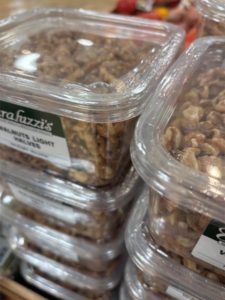- PEF and PET packaging: PEF is a plant-based rival to PET with better performance.
- Why it matters: PEF fits existing PET lines — no overhaul needed.
- Top benefits: Better barriers, more heat resistance, stronger, greener.
- Big hurdles: High cost, low supply, no recycling system (yet).
You’ve seen this story before — another “revolutionary” bio-based packaging material promising sustainability without compromise. You’ve watched PLA spoons melt in hot soup and seen PHA materials require costly blends to function. Meanwhile, PET remains the top choice in food packaging due to its outstanding performance and cost. This can leave you torn between your environmental goals and the demands of running a business.
The issue isn’t your commitment to sustainability. It’s that bio-based options often don’t match PET’s barrier properties, heat resistance, and ease of processing.
But what if there was a plant-based material that didn’t just match PET’s performance, but actually exceeded it?
Meet PEF (polyethylene furanoate), a bio-based polymer. This material has the potential to revolutionize sustainable food packaging. PEF is different from other bio-based materials. It offers better barrier properties, higher heat resistance, and more durability than regular PET. Additionally, it offers genuine environmental benefits.
After our previous conversations with Conor Carlin covering PLA and PHA, we reconnected to discuss PEF. Conor serves as President of Clefs Advisory LLC and possesses comprehensive experience where packaging meets sustainability. His credentials include holding the 2024 presidency of the Society of Plastics Engineers and his former role as General Manager for ILLIG in North America. His expertise spans materials science, packaging technologies, policy frameworks, commercial strategy, and market analysis.
This article examines the differences between PEF and PET, as well as other bio-based options. It reviews PEF’s real-world benefits and checks the current development timeline. Additionally, it provides practical guidance for food businesses considering this new technology.
What Makes PEF Different?
 Think of PEF as PET’s plant-based cousin. While PLA (sometimes, embarrassingly) melts in hot soup and PHA needs a buddy system to work correctly, PEF walks right up to PET and says, “Anything you can do, I can do better.”
Think of PEF as PET’s plant-based cousin. While PLA (sometimes, embarrassingly) melts in hot soup and PHA needs a buddy system to work correctly, PEF walks right up to PET and says, “Anything you can do, I can do better.”
Here’s the clever part: PET and PEF are basically twins with one key difference. PET obtains one of its main ingredients, terephthalic acid (PTA), from oil, whereas PEF substitutes it with a material derived from plant sugars.
Both materials share the same second ingredient (let’s call it MEG to keep things simple), which means PEF acts a lot like PET during manufacturing. This is significant because it means companies may not need to discard their existing equipment and start over. Also, PEF can be made with bio-based MEG.
Think about it this way: PLA and PHA are like switching from a gas car to a horse and buggy — completely different systems. PEF is more like switching from a gas car to an electric version of the same model. The same familiar experience, just powered by something better for the planet.
Performance That Actually Competes
PEF outperforms PET in several key ways, unlike other bio-based options that often fall short.
Superior barrier properties vs. PET: PEF blocks oxygen, carbon dioxide, and moisture significantly better than PET. PET provides decent barrier properties, but PEF outperforms it. This means that products such as fresh produce, meats, and beverages can stay fresh longer with PEF packaging than with PET.
Enhanced heat resistance vs. PET: PEF has a higher “glass transition temperature,” meaning it melts at a higher temperature than PET. So, it’s better for uses where PET could soften or bend. This advantage over PET makes it ideal for hot-fill applications, microwave-safe packaging, and other heat-intensive uses. PET’s temperature limits often hold back these options.
Strength and processing efficiency vs. PET: PEF’s structure may enable thinner walls. It can match the strength of thicker PET packaging. This can save money and boost sustainability compared to similar uses of PET.
PEF stands out from materials like PLA and PHA. It doesn’t just match PET; it aims to outperform it and provide environmental benefits.
The Sustainability Story
 PEF offers environmental advantages over traditional PET without sacrificing functionality:
PEF offers environmental advantages over traditional PET without sacrificing functionality:
Bio-based content vs. PET: PET is made from oil, while PEF is made from plants. PEF uses a plant-based ingredient called FDCA, which means it depends less on fossil fuels like petroleum.
Lower emissions from PEF production: Early studies show that making PEF releases fewer greenhouse gases than PET. This could lower the carbon footprint of packaging that currently uses PET.
Recyclability comparison with PET: PEF is designed to be recyclable, similar to PET. PEF will initially require its own collection and processing systems, unlike PET, which already has a well-established recycling setup. Early studies indicate that small amounts of PEF, approximately 2%, can be easily mixed with PET. However, higher levels may need special recycling methods.
PEF, like all plant-based materials, has concerns. These include land use, water use, and competition for farming resources with food production. This is especially true when compared to PET derived from petroleum.
The Current Reality
Don’t expect to see PEF products on shelves immediately. Avantium, a Dutch company, leads development. It spun off from Shell in the early 2000s and later partnered with BASF and went public in 2017. They’re methodically scaling from lab tests to pilot plants in the Netherlands.
The timeline is significant — new polymers typically take 30-35 years to reach commercial scale. PLA took over 20 years and billions of dollars to become widely available. PEF is following a similar path but with more consistent funding and development.
The Challenges Ahead
 PEF faces significant hurdles that could affect its ability to compete with established PET:
PEF faces significant hurdles that could affect its ability to compete with established PET:
- Premium pricing vs. PET: Initial PEF costs will be significantly higher than those of established, globally produced PET.
- Limited supply vs. PET availability: Small production means a slow market entry. This differs from PET, which has a substantial global production base.
- Infrastructure development: PEF lacks the mature recycling systems of PET. Therefore, it will require new collection and processing systems from the outset.
- Regulatory timeline: Food contact applications need extensive safety testing. The FDA has approved PET and it has had decades of regulatory acceptance.
- Financial support: Avantium has invested steadily for 15 to 20 years. This is like the ongoing support that helped make PET commercially viable years ago. This contrasts with the inconsistent funding that has plagued other bio-based alternatives.
What This Means for Food Businesses
For companies evaluating sustainable packaging options:
Monitor development: Follow Avantium’s progress and connect with packaging suppliers conducting trials. Early awareness provides a competitive advantage when materials become available.
Strategic testing: When samples become available, test with your specific products. Focus on items that could benefit most from PEF’s superior barrier properties or heat resistance.
Plan implementation: Consider which product lines justify premium pricing for sustainability benefits. Premium products or those requiring extended shelf life could be ideal starting points.
Prepare your story: Share your sustainability goals. Explain how PEF fits into your overall strategy.
Ding, Ding, Ding! Do We Have a Winner?
 PEF stands out because it’s the first sustainable packaging material that performs better than PET, not worse. PLA and PHA keep getting knocked out early due to high costs and poor performance. In contrast, PEF demonstrates that plant-based materials can outperform their petroleum-based counterparts. They just need more time and money to make that happen.
PEF stands out because it’s the first sustainable packaging material that performs better than PET, not worse. PLA and PHA keep getting knocked out early due to high costs and poor performance. In contrast, PEF demonstrates that plant-based materials can outperform their petroleum-based counterparts. They just need more time and money to make that happen.
Think of PEF as that promising boxer training hard in the gym, throwing punches that look impressive on paper. PET is the top heavyweight champ. It has dominated for decades, with proven performance, reliable supply chains, and unbeatable economics. PEF may have the potential to challenge the champ, but currently, it’s all theory and limited lab results.
Let’s be honest: PET isn’t going anywhere anytime soon. It’s cheap, reliable, and recyclable when systems work properly. Continue to optimize your current PET operations, as that’s your reality today. PEF is worth watching, but don’t bet your business on a contender that’s still years away from proving itself in real-world conditions.
Do you want to learn more about plastic packaging and sustainability? Visit our Learning Center today and explore a vast array of topics.
Would you like to know more about Conor Carlin and his work at Clefs Advisory LLC? Connect with him on LinkedIn today.


